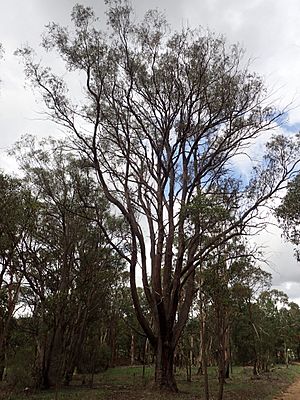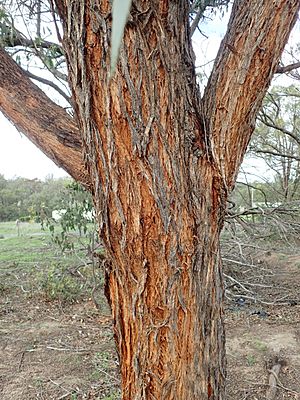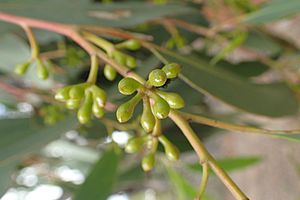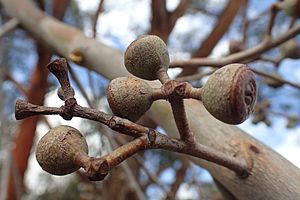Youman's stringybark facts for kids
Quick facts for kids Youman's stringybark |
|
|---|---|
 |
|
| Eucalyptus youmanii near Uralla | |
| Scientific classification | |
| Genus: |
Eucalyptus
|
| Species: |
youmanii
|
| Synonyms | |
|
|
Eucalyptus youmanii, also known as Youman's stringybark, is a special type of tree. It is a small to medium-sized tree that grows only in eastern Australia. This tree has rough, stringy bark on its trunk and branches. It also has long, curved leaves, white flowers, and round, woody fruits.
Contents
Discovering Youman's Stringybark
Youman's stringybark is a tree that can grow up to 20 meters (about 65 feet) tall. It has a special woody swelling at its base called a lignotuber. This helps the tree regrow if it gets damaged, for example, by a bushfire.
What the Bark Looks Like
The bark on the trunk and branches is rough and stringy. It often has a greyish color and deep grooves.
Leaves and Flowers
Young plants have leaves that are egg-shaped to lance-shaped. These leaves are paler on their underside. As the tree grows, its adult leaves become longer and more curved. They are usually 55 to 160 millimeters long (about 2 to 6 inches).
The tree's flower buds grow in groups of seven. They are oval or diamond-shaped. When they open, they reveal white flowers. You can usually see this tree flowering in February and March.
Fruit of the Tree
After flowering, the tree produces woody fruits. These fruits are shaped like half a sphere, or a dome. They are typically 4 to 8 millimeters long and 7 to 13 millimeters wide.
Naming Youman's Stringybark
The scientific name Eucalyptus youmanii was first officially described in 1930. Two scientists, William Blakely and Ernest Norman McKie, gave it this name. They wrote about it in a scientific paper.
Who Was Thomas Youman?
The tree was named youmanii to honor Thomas Youman. He was a person who helped Blakely and McKie collect samples of the tree. They found these first samples on his farm in 1920.
Where Youman's Stringybark Grows
Youman's stringybark grows in woodlands. It prefers poor soils. You can find this tree in a specific area of eastern Australia. This area stretches from the Armidale-Guyra region in New South Wales up to near Stanthorpe in Queensland.




